-
Types of bones, where they are, and what theyre made of?
Compact bone: covers all external surfaces of bones, made of osteons
spongy bone: in flat & iregular bones, and long bones, made of trabeculae with spaces that contain bone marrow
-
What are osteons made of?
- lamellae (concentric circles of matrix)
- lacunae (space between lamellae with osteocytes, which secrete bone)
- canaliculi, small channels that connect osteocytes to each other and blood supply
- central canal (lined with endosteum, contains blood and nerves)
- perforating canal (perpendicular to central, carries blood and nerves from periosteum to centrals and medullary cavity)
-
What is spongy bone made of?
- trabeculae, which is made of:
- irregularly arranged lamellae
- canaliculi connect osteocytes in lacunae
- dont have canals, and are not osteons
- osteoclasts and osteoblasts on the surface
-
What does red bone marrow do? where is it?
- produces red blood cells
- in the spaces of trabeculae in spongy bone
-
What are the 2 divisions of the skeletal system?
- axial skeleton (80 bones) and appendicular skeleton (126 bones)
-
What is an articulation?
connection between bones (ex: humerus articulates with the scapula)
-
What is the axial skeleton bone groups?
- skull
- hyoid bone
- vertebral column
- thoracic cage (sternum and ribs)
-
What is the appendicular skeleton bone groups?
- pectoral girdle
- pelvic girdle
- upper limbs (arms, forearms, and hand)
- lower limbs (thighs, leg, and foot)
-
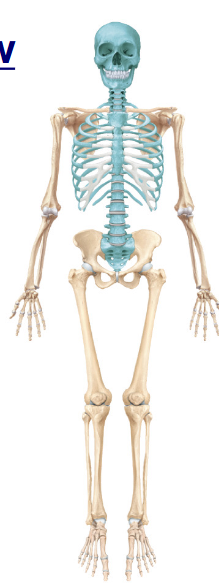
What skeletal division is this?
Axial Skeleton
-
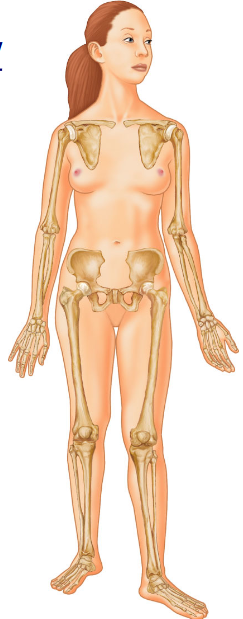
What skeletal division is this?
The appendicular division
-
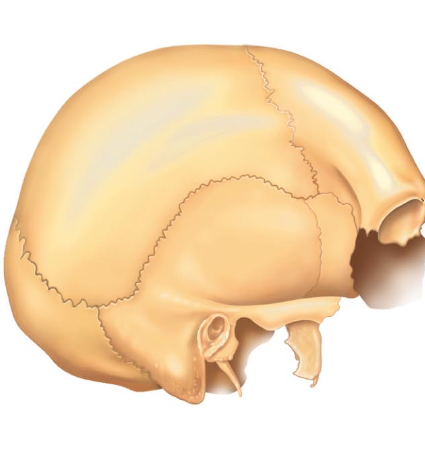
What bone grouping is this?
Cranium grouping in the skull, part of the axial division
-
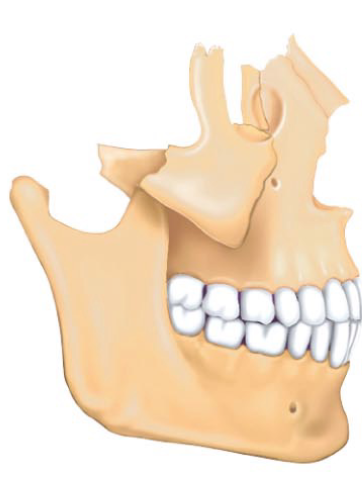
What bone grouping is this?
Facial bones in the skull, part of the axial division
-
What are the three bone groupings of the skull?
- cranium (8 bones, next to brain)
- facial bones (14 bones, nose and cheek bones down the face)
- auditory ossicles (6 bones, 3 on each side in the middle of ears)
-
What are the bones in the cranium group?
- 1 frontal (forehead)
- 2 parietal (top of head)
- 2 temporal (side of head)
- 1 sphenoid (behind eye)
- 1 ethmoid (superior and middle nasal chonchae)
- 1 occipital (back of head)
-
What are the bones in the facial group?
- 2 nasal (nose)
- 2 maxillae (upper jaw)
- 2 zygomatic (cheekbones)
- 2 lacrimal (medial in eye socket)
- 2 palatine (back of mouth)
- 2 inferior nasal chonchae
- 1 vomer (line in nasal cavity)
- 1 mandible (jaw)
-
What are the bones in the auditory ossicles group?
- this is for sound transmission
- 2 incus
- 2 malleus
- 2 stapes
-
What is the Hyoid bone?
- attached to muscles of tongue and neck, assists in swallowing
- no articulations at all (doesnt connect to other bones)
-
What are the five regions of the vertebral column?
- 26 vertebrae
- Cervical (7), thoracic (12), lumbar (5), sacrum (1), coccyx (1)
-
What are characteristics of the general vertebral structure?
- body (thick anterior portion)
- spinous process (1)
- transverse process (2)
- lamina (2) connects the two processes
- pedicle (2) connects body to transverse process
- vertebral foramen (hole for spinal cord)
- superior and inferior articular facets (to articulate with above and below vertebrae)
- intervertebral foramina (exit for spinal nerves)
-
What is a shared characteristic of C1 - C7?
- all have transverse foremen in each transverse process (for passage of vertebral arteries)
-
What is unique to C1 and C2?
They do not follow general vertebral structure?
-
C1, atlas does what and has what characteristics?
- no body or spinous process
- articulates with the occipital bone of the skull
- allows rotation of the head on neck for shaking yes motion
-
C2, axis does what and has what characteristics?
- dens (odontoid process)
- pivot joint around which atlas swivels
- allows rotation of head on neck for shaking no motion
-
What are the characteristics of C3-C7?
they follow the general vertebral structure
-
What's a defining feature of the thoracic vertebrae?
- they all articulate with ribs via costal facets
-
What do lumbar vertebrae do? What are their defining features?
- support upper body weight
- all have large bodies
- all have rectangular spinous processes
-
What are defining characteristics of the sacrum?
- its 5 fused vertebrae
- articulates with ilium (appendicular skeleton) and the 5th lumbar vertebrae (L5)
-
What are the defining characteristics of the coccyx?
- 3-5 fused vertebrae (usually 4)
- tailbone
-
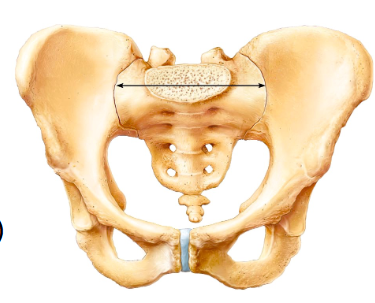
What is this? Where does it articulate?
Its the sacrum, articulates with the L5 vertebrae and the ilium
-
What is the curvature of the cervical, thoracic, and lumbar regions of the spine?
concave posterior, convex posterior, and concave posterior
-
What are some abnormal curvature?
- scoliosis (spinal column curves laterally)
- kyphosis (exaggerated thoracic curve, hunchback)
- lordosis (exaggerated lumbar curve)
-
What bones make up the thoracic cage?
- the sternum (breast bone)
- the ribs
-
What makes up the sternum?
- its a fusion of 3 bones:
- manubrium (superior)
- body (middle)
- xiphoid process (inferior)
-
How many ribs are there? where do they articulate? How do they work?
- 12 total ribs which all articulate with the T1-T12 vertebrae
- 7 superior pairs are the true ribs (directly articulate via costal (hyaline) cartilage to sternum)
- 5 inferior false ribs, 1-3 attach via costal cartilage to the cartilage of rib 7
- the last 2 false ribs don't attach at all (floating ribs)
-
What bones are in the pectoral girdle?
clavicle and scapula
-
What does the clavicle do?
- articulates with manubrium in the sternum
- articulates with the acromion process of the scapula
- connects the appendicular and axial skeletal divisions
-
What are the parts of the scapula?
- spine (runs along posterior surface)
- acromion process (articulates with clavicle)
- glenoid cavity (articulates with head of humerus)
- coracoid process (attachment point for muscles of arm and chest)
-
What is the pelvic girdle composed of?
- composed of 2 os coxae (hip bones) made by fusion of 3 bones:
ilium (superior, articulates with sacrum)
ischium (posterior)
pubis (anterior) left and right joined by pubic symphysis
- joints (pubic symphysis, and sacroiliac joint (sacrum and ilium))
- acetabulum articulates with head of femur
-
What bones make up the upper limb?
- humerus
- radius (lateral) and ulna (medial)
- carpals (8 bones, wrist)
- metacarpals (5 bones, palm)
- phalanges (14, digits)
-
What bones make up the lower limb?
- femur
- patella (knee cap)
- tibia (medial) and fibula (lateral)
- tarsals (7 bones, 2 are:
talus (articulates with tibia)
calcaneus (heel bone)
- metatarsals (5 bones, sole of foot)
- phalanges (14 bones, feet digits)
-
What are the components of long bones?
- diaphysis (shaft, body)
- epiphyses (proximal and distal extremities)
- epiphyseal plate (in children, hyaline cartilage used to grow)
- epiphyseal line (adult, where diaphysis and epiphysis meet)
- medullary cavity (red marrow in child, yellow in adult)
- periosteum (external surface of connective tissue)
- endosteum (internal, lines medullary cavity and canals)
- articular cartilage (hyaline, only at articulation points)
-
What is the periosteum?
- external surface of long bones
- made of 2 layers of connective tissue
inner: mainly osteoblasts and osteoclasts
outer: dense irregular
- allows bone to grow in diameter
-
What is articular cartilage?
- hyaline cartilage
- only at articulation points
- prevents friction between bones (no periosteum here)
-
What is endosteum?
- lines medullary cavity and the canals
- contains osteoblasts and osteoclasts
-
What is an articulation/joint? What are the 2 classes?
- point of contact between two or more bones
- structural or functional
-
What is the functional classification based on? what are the types?
- based on degree of movement
1. synarthrotic: immovable (skull sutures)
2. amphiarthrotic: slightly moveable (pubic symphysis)
3. diarthrotic: freely movable (hip, shoulder)
-
What is the structural classification based on? what are the types?
- based on presence/absence of joint cavity and the type of connective tissue that joins the bones
1. fibrous (no joint cavity, fibrous CT) (skull sutures)
2. cartilaginous (no joint cavity, cartilage CT) (pubic symphysis)
3. synovial (shoulder, elbow, hip, knee)
-
What is the structure of a synovial joint?
- articulating bones are connected by joint capsule and ligaments
- articular cartilage (hyaline) of bone
- space between bones is the joint cavity (contains synovial fluid)
- articular/joint capsule encloses the joint cavity
outer layer: fibrous capsule (attaches to periosteum)
inner layer: synovial membrane (CT) (secretes synovial fluid)
-
What are the types of synovial joints?
- grouped according to shape of articulating bones
1. plane/gliding (flat surfaces, sacroiliac)
2. hinge (concave/convex surfaces, elbow, knee)
3. pivot (projection in ring, dens (on axis) in atlas
4. ball & socket (great freedom of movement, humerus in glenoid fossa)

